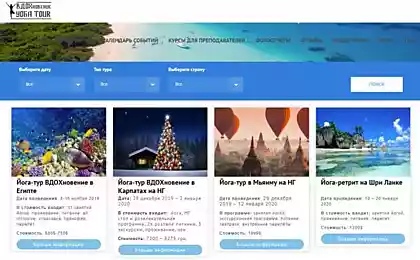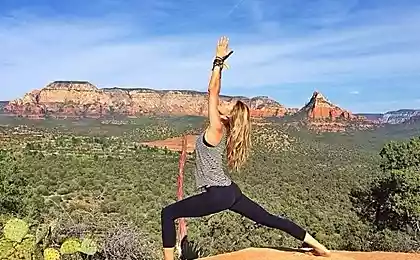581
The formula for the implementation of cherished desires
The yoga tradition offers a profound formula for the implementation of cherished desires, not requiring changes. It is a practice Sankalpa (intention).

Almost every new year's statement begins with the words "I will." We call on our willpower and pledge to change not only what we do but who we are. We set goals and imagine how happy you will be, get what you want.
But if we yoga teaches anything, it's how much of a difference between "my will" and "divine will". Often the desire to change something in your life arises from a deluded ego, emotions and conditioning. And most often fails because it starts from discontent with what is, and reinforces the mistaken identification of happiness with getting what you want.
The yoga tradition offers a modern alternative to a similar new year's statements – the practice of Sankalpa, or Intention. Sankalpa begins with a radical message that you already have what you want to be to fulfill your life's Dharma. You only need to focus, to be reunited with their cherished desires ... and send divine energy.
Sankalpa: beyond statements.
Rod Strike, the founder of Para-yoga, explains that the chief architect of our life is the mind. To create the life for which we are here, we must again and again return our attention to the Dharma, their deep intentions and inner divine qualities.
Sankalpa that is. Stryker explains that "Kalpa" means "vow" or "rule of that case to comply with the rules above all", and "San" refers to the connection with the Supreme truth. That is, it is a vow and promise to uphold the highest truth. "By definition, a Sankalpa should be a reverence for the deep meaning of our lives, our Dharma – the primary reasons for stay here," he says. Sankalpa is a statement designed to coordinate your every choice with your true nature.
While typical new year's statement is forgotten in a few weeks, if not days, once the enthusiasm fizzles Sankalpa does not require to implement the change, the willpower that comes from ego. According to Dr. Richard Miller, clinical psychologist and teacher of Advaita Vedanta and Kashmir nondual traditions, a Sankalpa contains all that is required for its full implementation: Ricky (great will and energy), Kriya (action) and Jnana (wisdom for an action).
"All these aspects of the Divine living in us. When the true Sankalpa, we awaken to these three qualities, and they begin to manifest in us," says Miller. "No need to think where to take forces for the realization of the desired. Energy and will are already present in us. Sankalpa only helps to find a Way to bring it into the world."
Two types of Intent
Sankalpa exists in two forms. The first, which Miller calls the cherished desire is a reflection of your true nature. This type Sankalpa comprehensive and requires no changes or actions. It is simply a statement of who you are, for example: "I have a holistic and healed" or "I am peace." According to Miller, such an intention does not come from the intellectual mind, but from the inner depths of the infinite mysteries of who we really are. After, our mind gets information a certain direction, which we must accept, or accept in our lives."
Sankalpa can be expressed in another way: as a specific purpose or goal. Brenna Gian, certified instructor Couple-Yoga in the Bay area, San Francisco, explains: "Even after realizing your destiny not all come at once. To live the mission of the soul, must reach a certain critical stage."
Setting specific goals helps to coordinate each of your choice from the cherished desire. Gian proposes to look to the future, asking the question, what exactly needs to happen for your progress. Your specific Sankalpa indicates what to do and where to direct the energy to achieve their big life goals.
How to find your Sankalpa?
Listen to yourself, and you will find your Sankalpa. Your cherished desire is already There, it just needs to consider, hear, and feel. No need to invent anything, your mind doesn't need to rush in search.
Miller describes the three stages of listening to yourself in the tradition of Vedanta:
Anna Douglas, a yoga therapist at Banhoff, AB, specializiruetsya on how to guide students in the sometimes very difficult to answer the question "What do I really want?" and encourages just to start this search, regardless of external circumstances. Douglas believes that any goal can start that way. "Even a simple, small desire can lead to dream. It can arise from the condition, but if you trust the practice and to follow the voice of the heart, it will lead you to the core of your being".
To hear your heart's desire is to work on those goals that you have, but ask yourself what's behind them. For example, one of the most common goals we hear Douglas is "I want to be slender," or "I want to lose weight". In this case, it asks the client to imagine what his life is, and how it will feel having achieved this goal. This feeling of self-love, physical well-being or freedom? What feeling he wants? What is this longing in the soul, and what does it point to?
Another common goal is the rejection of something, for example, Smoking or shopping. To explore what lies behind this, ask yourself what desire will be achieved through this action. Whether you are looking for rest, freedom from pain or acceptance from others? Find this deep hunger, longing. They will tell you what actually wants your heart. "I want to quit Smoking" in the process, can be transformed into a deep desire, "I want to take care of your body," and if you go further, there is Sankalpa, "I love my body" or even "I am love". It's evolution, but it still has the original intention to quit Smoking.
Claim The Sankalpa.
It is natural to formulate desire as "I want" and an intention as "I will" or "I won't", but those words are not enough truth cherished desire and connection with the Dharma. "Sankalpa – this is not a petition and not a prayer, says Miller. "This is a profoundly true statement that is already there at the moment."
Therefore, Sankalpa and desire and the specific intention – should be formulated at the present time. For example, instead of "I want to be more compassionate" you could say "Compassion is my true nature" or "I am compassion". Instead of "I will not eat meat," Your specific Sankalpa could be: "With compassion to your body and to all living creatures I eat vegetarian food." Stating the Sankalpa in the present tense, You recognize the immense will power, and truth, manifested together with Your cherished desire. Besides, it serves as a reminder that everything you need is already in You.
Sow the seed of his Sankalpa.
The core of the practice is the repetition of Sankalpa. When you keep it in mind, then increase their intention to render homage to its treasured desire. But the simple repetition of Sankalpa enough. "Once you say you want something, part of You recognizes that you do not have, explains Stryker. — The repetition of desire reinforces the belief that You are not". When an unconscious act based on the failure or perceived inadequacy, the energy that supports the intention of waning.
Stryker cites a tantric text, Tripura Rahasya, which teaches that the qualities of the mind, repeating the Sankalpa determines its effect. To fully realize your intention, the mind needs to switch from the dualistic thinking in nondual awareness. Therefore, meditation is the most fertile ground for Sankalpa practice. It returns the mind to a state of wholeness of the present moment. "The longer we are able to effortlessly abide in the space of oneness, the faster our Sankalpa will be filled with energy, explains Stryker. — The mind becomes the most powerful factor that help us in fulfilling our intentions."
The most favorable state of mind for remembering your Sankalpa is the direct experience of what you already are open, infinite, and perfect. Nondual teachings describe this as the Space of Pure Being. "Otherwise the process involves ego, says Miller. – That is, You come to the intention of "something is wrong and I must fix it". Need to connect to the qualities of existence that is already fully and completely holistically.
One of the most powerful practices you enter this state of yoga Nidra. Although Nidra means "sleep", actually is a process of awakening to your true nature. Yoga Nidra systematically relaxes the body and mind and leads to deep awareness. You are conscious and awake, but your experience is not identified with body or mind. Thus, the voltage between Prakriti and Purusha dissolves, and you rest in peace, wisdom and love of your true nature.
Anna Douglas explains: "yoga Nidra is a very deep level of openness. Our borders are dissolved, and there remains only pure being". When you recall your Sankalpa in the waking state, it can bring doubt or force of the ego. When you call the Sankalpa in yoga Nidra, a wish arises as an experience in body-mind, and at this moment it is absolutely alive.
How to energize your intention?
After you have found and have sown the seed of its Sankalpa, you can begin the process of strengthening Shakti Sankalpa energy necessary for the realization of intentions. According to Gyan, each of Your choice or supports or undermines Your resolve. This is true even of those decisions which, it would seem, has no direct relation with your specific intention. Suppose you realize that sugar destroys your energy and sleep. But from time to time you "forget" about it and still eat sweets. Every time you do that, increasing the part of you that says "fuck awareness and intention". You give strength to that part of you which is against your consciousness.
On the other hand, every conscious choice is an opportunity to strengthen the Sankalpa Shakti. This is the basis of the practice of para-Yoga, which is called "starting point." Instructions are simple: choose something non-constructive that you are constantly doing and commit not to do this for 40 days. Nail biting, drinking coffee, watching TV – you can choose any habit. It may be related to your Sankalpa, but not necessarily.
However, the practice of starting point is not the elimination of the habit. When approaching the moment of momentum, remember your Sankalpa instead follow the usual instinct. Thus, the habit becomes a reminder to indicate the intention.
In the space between the impulse to action and the repetition of Sankalpa useful to take a pause and invite the mind to a state of unity. Enjoy a few conscious breaths and notice the pause between cycles of breathing. "Use this moment to remember your true nature. In this state – space integrity and unity and not confusion, lack or even hope – remember your Sankalpa, says Stryker. — This is the key to the starting point of your practice. Sankalpa is not working in my mind, thinking about his failure.".
Even if you've forgotten your intention, it can be transformed to support Sankalpa. Anna Douglas uses the memory of these lost opportunity to prepare students for future choices: "Go back to the moment where you lost it. Return to this feeling of compulsion, rethink it and re-create this moment. When you are already completely in this feeling, imagine that you are susceptible to habit. Take the entire force of your Sankalpa and allow yourself to feel cherished desire throughout the body. Now again remember the feeling of compulsion. Travel back and forth, each time strengthening the sense of their wishes."
This approach applies not only to the practice a starting point, but all your choices. Miller advises daily to reconsider their actions from the point of view of his intentions. For example, let's imagine that your dearest wish – "I am filled with divine compassion," your specific Sankalpa is: "At every meeting I treat myself and others with kindness." Looking back at your day, ask yourself: "How I was unkind, mean and cruel?" Ask this question not from a position of severe self-criticism, but with genuine interest to see how this happened. What was the situation? What were your thoughts? How was it felt? What you said or didn't say? How it felt?
Miller refers to these deviations not as failures, but rather as a movement From itself. A momentary lack of compassion – it's not who you Are. Sankalpa really describes who we are and how we move in the world, being in harmony with others." Life is a process that teaches to be in harmony with our true nature, but sometimes we get lost on the way.
When you notice how you move away From yourself, imagine what you would think, say or do that would be consistent with your decision? How would it feel? Look at yourself in action and feel it in the body. Imagine this response until, until you feel like you actually did it. According to Douglas, this practice helps dissolve the conditioning, separating us from our Dharma and from awakening to your true nature".
The key to the fulfillment of Dharma
When you first begin working with Sankalpa, the practice can seem full of contradictions. You start with the definition desired, but the only way to do so is to admit that you are already there, you got it. Set measurable goals and focus on breaking the habits. But in every moment when you are acting according to these goals, first and foremost, remember that you are already perfect and complete.
According to Rod Stryker, this apparent contradiction is the essence of Sankalpa practice a non-dualistic teachings. "All of this comes from the idea that each of us is both being and becoming. There's a part of us, Paramatma, which is transcendental, essentially single and doesn't need anything. There is also the Jiva Atman – the part of us that comes into life with a purpose and a destiny and is always in the making, explains Stryker. — To fulfill your Dharma, it is necessary to integrate these two seemingly opposite aspects of being." It is vital for happiness to go both ways at the same time. Direct your energy into the intention, but be alert to its nature, which is immutable regardless of whether you reach the goal or not. Between the target and its implementation enjoy life as possible! published
Author: Kelly Mcgonigal
P. S. And remember, only by changing their consumption — together we change the world! © Join us at Facebook , Vkontakte, Odnoklassniki
Source: 9journal.com.ua/%D0%BA%D0%B0%D0%BA-%D1%81%D0%BE%D0%B7%D0%B4%D0%B0%D1%82%D1%8C-%D1%81%D0%B0%D0%BD%D0%BA%D0%B0%D0%BB%D1%8C%D0%BF%D1%83-%D0%BD%D0%B0%D0%BC%D0%B5%D1%80%D0%B5%D0%BD%D0%B8%D0%B5/

Almost every new year's statement begins with the words "I will." We call on our willpower and pledge to change not only what we do but who we are. We set goals and imagine how happy you will be, get what you want.
But if we yoga teaches anything, it's how much of a difference between "my will" and "divine will". Often the desire to change something in your life arises from a deluded ego, emotions and conditioning. And most often fails because it starts from discontent with what is, and reinforces the mistaken identification of happiness with getting what you want.
The yoga tradition offers a modern alternative to a similar new year's statements – the practice of Sankalpa, or Intention. Sankalpa begins with a radical message that you already have what you want to be to fulfill your life's Dharma. You only need to focus, to be reunited with their cherished desires ... and send divine energy.
Sankalpa: beyond statements.
Rod Strike, the founder of Para-yoga, explains that the chief architect of our life is the mind. To create the life for which we are here, we must again and again return our attention to the Dharma, their deep intentions and inner divine qualities.
Sankalpa that is. Stryker explains that "Kalpa" means "vow" or "rule of that case to comply with the rules above all", and "San" refers to the connection with the Supreme truth. That is, it is a vow and promise to uphold the highest truth. "By definition, a Sankalpa should be a reverence for the deep meaning of our lives, our Dharma – the primary reasons for stay here," he says. Sankalpa is a statement designed to coordinate your every choice with your true nature.
While typical new year's statement is forgotten in a few weeks, if not days, once the enthusiasm fizzles Sankalpa does not require to implement the change, the willpower that comes from ego. According to Dr. Richard Miller, clinical psychologist and teacher of Advaita Vedanta and Kashmir nondual traditions, a Sankalpa contains all that is required for its full implementation: Ricky (great will and energy), Kriya (action) and Jnana (wisdom for an action).
"All these aspects of the Divine living in us. When the true Sankalpa, we awaken to these three qualities, and they begin to manifest in us," says Miller. "No need to think where to take forces for the realization of the desired. Energy and will are already present in us. Sankalpa only helps to find a Way to bring it into the world."
Two types of Intent
Sankalpa exists in two forms. The first, which Miller calls the cherished desire is a reflection of your true nature. This type Sankalpa comprehensive and requires no changes or actions. It is simply a statement of who you are, for example: "I have a holistic and healed" or "I am peace." According to Miller, such an intention does not come from the intellectual mind, but from the inner depths of the infinite mysteries of who we really are. After, our mind gets information a certain direction, which we must accept, or accept in our lives."
Sankalpa can be expressed in another way: as a specific purpose or goal. Brenna Gian, certified instructor Couple-Yoga in the Bay area, San Francisco, explains: "Even after realizing your destiny not all come at once. To live the mission of the soul, must reach a certain critical stage."
Setting specific goals helps to coordinate each of your choice from the cherished desire. Gian proposes to look to the future, asking the question, what exactly needs to happen for your progress. Your specific Sankalpa indicates what to do and where to direct the energy to achieve their big life goals.
How to find your Sankalpa?
Listen to yourself, and you will find your Sankalpa. Your cherished desire is already There, it just needs to consider, hear, and feel. No need to invent anything, your mind doesn't need to rush in search.
Miller describes the three stages of listening to yourself in the tradition of Vedanta:
- First, sravana, is the willingness to hear the whisperings of your innermost desires. Need some courage to listen to his heart, to the silence and stillness of the mind, which come to you in meditation.
- The second state, manana, is an act of reversal and greetings to the message inside. When he heard the call, you need to be ready to truly feel it and deeply comprehend.
- The final stage, nididhyasana, is the willingness to do what is required for the realization of the cherished desire. "It will encourage you to manifestation in the world– says Miller– and we must be ready to act."
Anna Douglas, a yoga therapist at Banhoff, AB, specializiruetsya on how to guide students in the sometimes very difficult to answer the question "What do I really want?" and encourages just to start this search, regardless of external circumstances. Douglas believes that any goal can start that way. "Even a simple, small desire can lead to dream. It can arise from the condition, but if you trust the practice and to follow the voice of the heart, it will lead you to the core of your being".
To hear your heart's desire is to work on those goals that you have, but ask yourself what's behind them. For example, one of the most common goals we hear Douglas is "I want to be slender," or "I want to lose weight". In this case, it asks the client to imagine what his life is, and how it will feel having achieved this goal. This feeling of self-love, physical well-being or freedom? What feeling he wants? What is this longing in the soul, and what does it point to?
Another common goal is the rejection of something, for example, Smoking or shopping. To explore what lies behind this, ask yourself what desire will be achieved through this action. Whether you are looking for rest, freedom from pain or acceptance from others? Find this deep hunger, longing. They will tell you what actually wants your heart. "I want to quit Smoking" in the process, can be transformed into a deep desire, "I want to take care of your body," and if you go further, there is Sankalpa, "I love my body" or even "I am love". It's evolution, but it still has the original intention to quit Smoking.
Claim The Sankalpa.
It is natural to formulate desire as "I want" and an intention as "I will" or "I won't", but those words are not enough truth cherished desire and connection with the Dharma. "Sankalpa – this is not a petition and not a prayer, says Miller. "This is a profoundly true statement that is already there at the moment."
Therefore, Sankalpa and desire and the specific intention – should be formulated at the present time. For example, instead of "I want to be more compassionate" you could say "Compassion is my true nature" or "I am compassion". Instead of "I will not eat meat," Your specific Sankalpa could be: "With compassion to your body and to all living creatures I eat vegetarian food." Stating the Sankalpa in the present tense, You recognize the immense will power, and truth, manifested together with Your cherished desire. Besides, it serves as a reminder that everything you need is already in You.
Sow the seed of his Sankalpa.
The core of the practice is the repetition of Sankalpa. When you keep it in mind, then increase their intention to render homage to its treasured desire. But the simple repetition of Sankalpa enough. "Once you say you want something, part of You recognizes that you do not have, explains Stryker. — The repetition of desire reinforces the belief that You are not". When an unconscious act based on the failure or perceived inadequacy, the energy that supports the intention of waning.
Stryker cites a tantric text, Tripura Rahasya, which teaches that the qualities of the mind, repeating the Sankalpa determines its effect. To fully realize your intention, the mind needs to switch from the dualistic thinking in nondual awareness. Therefore, meditation is the most fertile ground for Sankalpa practice. It returns the mind to a state of wholeness of the present moment. "The longer we are able to effortlessly abide in the space of oneness, the faster our Sankalpa will be filled with energy, explains Stryker. — The mind becomes the most powerful factor that help us in fulfilling our intentions."
The most favorable state of mind for remembering your Sankalpa is the direct experience of what you already are open, infinite, and perfect. Nondual teachings describe this as the Space of Pure Being. "Otherwise the process involves ego, says Miller. – That is, You come to the intention of "something is wrong and I must fix it". Need to connect to the qualities of existence that is already fully and completely holistically.
One of the most powerful practices you enter this state of yoga Nidra. Although Nidra means "sleep", actually is a process of awakening to your true nature. Yoga Nidra systematically relaxes the body and mind and leads to deep awareness. You are conscious and awake, but your experience is not identified with body or mind. Thus, the voltage between Prakriti and Purusha dissolves, and you rest in peace, wisdom and love of your true nature.
Anna Douglas explains: "yoga Nidra is a very deep level of openness. Our borders are dissolved, and there remains only pure being". When you recall your Sankalpa in the waking state, it can bring doubt or force of the ego. When you call the Sankalpa in yoga Nidra, a wish arises as an experience in body-mind, and at this moment it is absolutely alive.
How to energize your intention?
After you have found and have sown the seed of its Sankalpa, you can begin the process of strengthening Shakti Sankalpa energy necessary for the realization of intentions. According to Gyan, each of Your choice or supports or undermines Your resolve. This is true even of those decisions which, it would seem, has no direct relation with your specific intention. Suppose you realize that sugar destroys your energy and sleep. But from time to time you "forget" about it and still eat sweets. Every time you do that, increasing the part of you that says "fuck awareness and intention". You give strength to that part of you which is against your consciousness.
On the other hand, every conscious choice is an opportunity to strengthen the Sankalpa Shakti. This is the basis of the practice of para-Yoga, which is called "starting point." Instructions are simple: choose something non-constructive that you are constantly doing and commit not to do this for 40 days. Nail biting, drinking coffee, watching TV – you can choose any habit. It may be related to your Sankalpa, but not necessarily.
However, the practice of starting point is not the elimination of the habit. When approaching the moment of momentum, remember your Sankalpa instead follow the usual instinct. Thus, the habit becomes a reminder to indicate the intention.
In the space between the impulse to action and the repetition of Sankalpa useful to take a pause and invite the mind to a state of unity. Enjoy a few conscious breaths and notice the pause between cycles of breathing. "Use this moment to remember your true nature. In this state – space integrity and unity and not confusion, lack or even hope – remember your Sankalpa, says Stryker. — This is the key to the starting point of your practice. Sankalpa is not working in my mind, thinking about his failure.".
Even if you've forgotten your intention, it can be transformed to support Sankalpa. Anna Douglas uses the memory of these lost opportunity to prepare students for future choices: "Go back to the moment where you lost it. Return to this feeling of compulsion, rethink it and re-create this moment. When you are already completely in this feeling, imagine that you are susceptible to habit. Take the entire force of your Sankalpa and allow yourself to feel cherished desire throughout the body. Now again remember the feeling of compulsion. Travel back and forth, each time strengthening the sense of their wishes."
This approach applies not only to the practice a starting point, but all your choices. Miller advises daily to reconsider their actions from the point of view of his intentions. For example, let's imagine that your dearest wish – "I am filled with divine compassion," your specific Sankalpa is: "At every meeting I treat myself and others with kindness." Looking back at your day, ask yourself: "How I was unkind, mean and cruel?" Ask this question not from a position of severe self-criticism, but with genuine interest to see how this happened. What was the situation? What were your thoughts? How was it felt? What you said or didn't say? How it felt?
Miller refers to these deviations not as failures, but rather as a movement From itself. A momentary lack of compassion – it's not who you Are. Sankalpa really describes who we are and how we move in the world, being in harmony with others." Life is a process that teaches to be in harmony with our true nature, but sometimes we get lost on the way.
When you notice how you move away From yourself, imagine what you would think, say or do that would be consistent with your decision? How would it feel? Look at yourself in action and feel it in the body. Imagine this response until, until you feel like you actually did it. According to Douglas, this practice helps dissolve the conditioning, separating us from our Dharma and from awakening to your true nature".
The key to the fulfillment of Dharma
When you first begin working with Sankalpa, the practice can seem full of contradictions. You start with the definition desired, but the only way to do so is to admit that you are already there, you got it. Set measurable goals and focus on breaking the habits. But in every moment when you are acting according to these goals, first and foremost, remember that you are already perfect and complete.
According to Rod Stryker, this apparent contradiction is the essence of Sankalpa practice a non-dualistic teachings. "All of this comes from the idea that each of us is both being and becoming. There's a part of us, Paramatma, which is transcendental, essentially single and doesn't need anything. There is also the Jiva Atman – the part of us that comes into life with a purpose and a destiny and is always in the making, explains Stryker. — To fulfill your Dharma, it is necessary to integrate these two seemingly opposite aspects of being." It is vital for happiness to go both ways at the same time. Direct your energy into the intention, but be alert to its nature, which is immutable regardless of whether you reach the goal or not. Between the target and its implementation enjoy life as possible! published
Author: Kelly Mcgonigal
P. S. And remember, only by changing their consumption — together we change the world! © Join us at Facebook , Vkontakte, Odnoklassniki
Source: 9journal.com.ua/%D0%BA%D0%B0%D0%BA-%D1%81%D0%BE%D0%B7%D0%B4%D0%B0%D1%82%D1%8C-%D1%81%D0%B0%D0%BD%D0%BA%D0%B0%D0%BB%D1%8C%D0%BF%D1%83-%D0%BD%D0%B0%D0%BC%D0%B5%D1%80%D0%B5%D0%BD%D0%B8%D0%B5/























